BUS 300 - Workplace Relations and Discrimination: Analysis Report
VerifiedAdded on 2022/09/12
|14
|3310
|21
Report
AI Summary
This report, submitted by a student, examines workplace discrimination with a focus on gender and age-related salary discrepancies. The study utilizes R studio for statistical analysis, addressing the question of whether employees are paid differently based on their gender and age. The literature review covers gender and age discrimination, highlighting wage gaps and historical perspectives. The analysis includes descriptive statistics and regression modeling to determine the relationship between salary, age, gender, and service. The findings reveal that age is a statistically significant factor influencing salary, with older employees potentially earning more. The analysis also indicates a salary difference between genders, suggesting potential discrimination against women. The report acknowledges limitations, such as the absence of experience and age groups, and emphasizes that the results should be viewed in context.
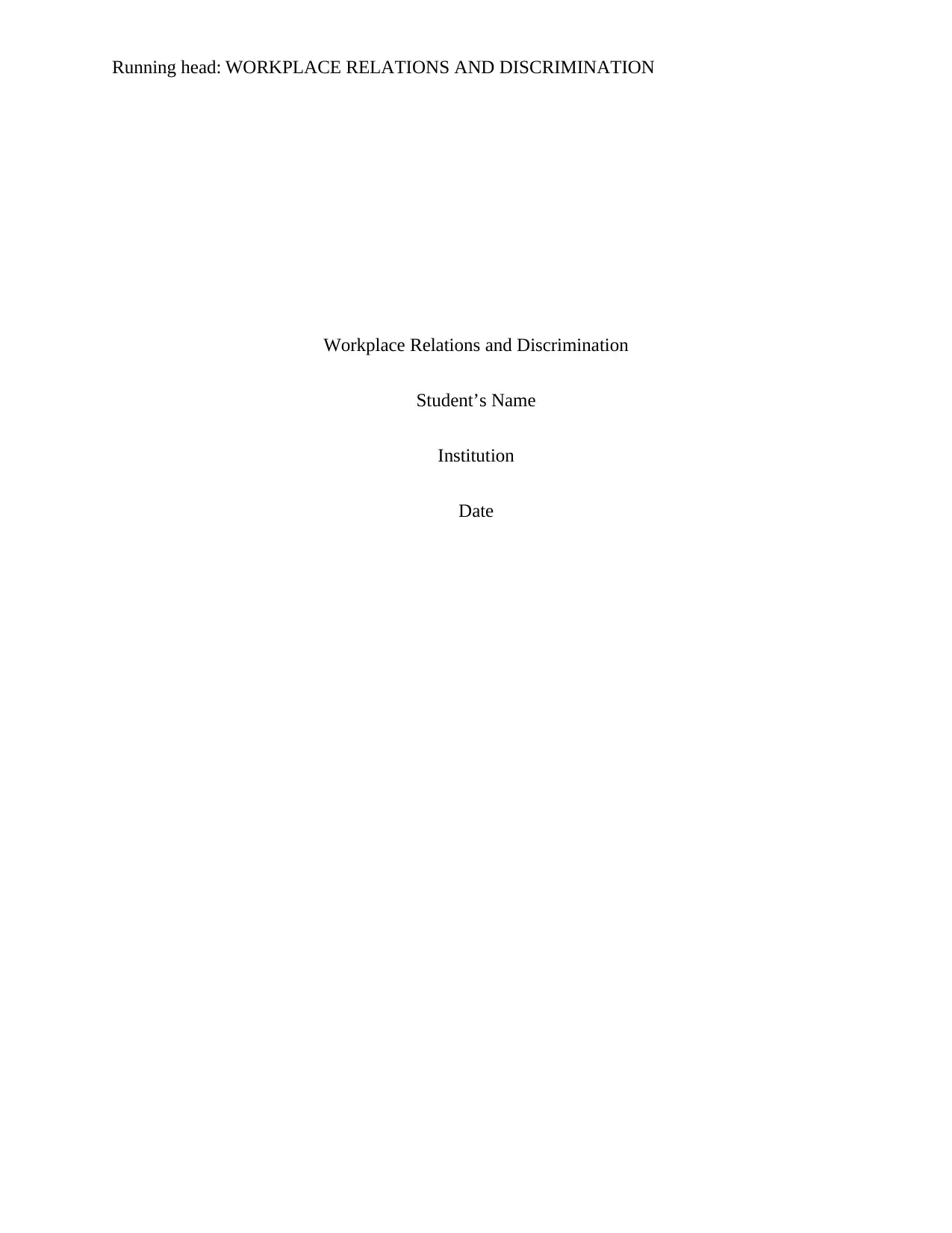
Running head: WORKPLACE RELATIONS AND DISCRIMINATION
Workplace Relations and Discrimination
Student’s Name
Institution
Date
Workplace Relations and Discrimination
Student’s Name
Institution
Date
Paraphrase This Document
Need a fresh take? Get an instant paraphrase of this document with our AI Paraphraser
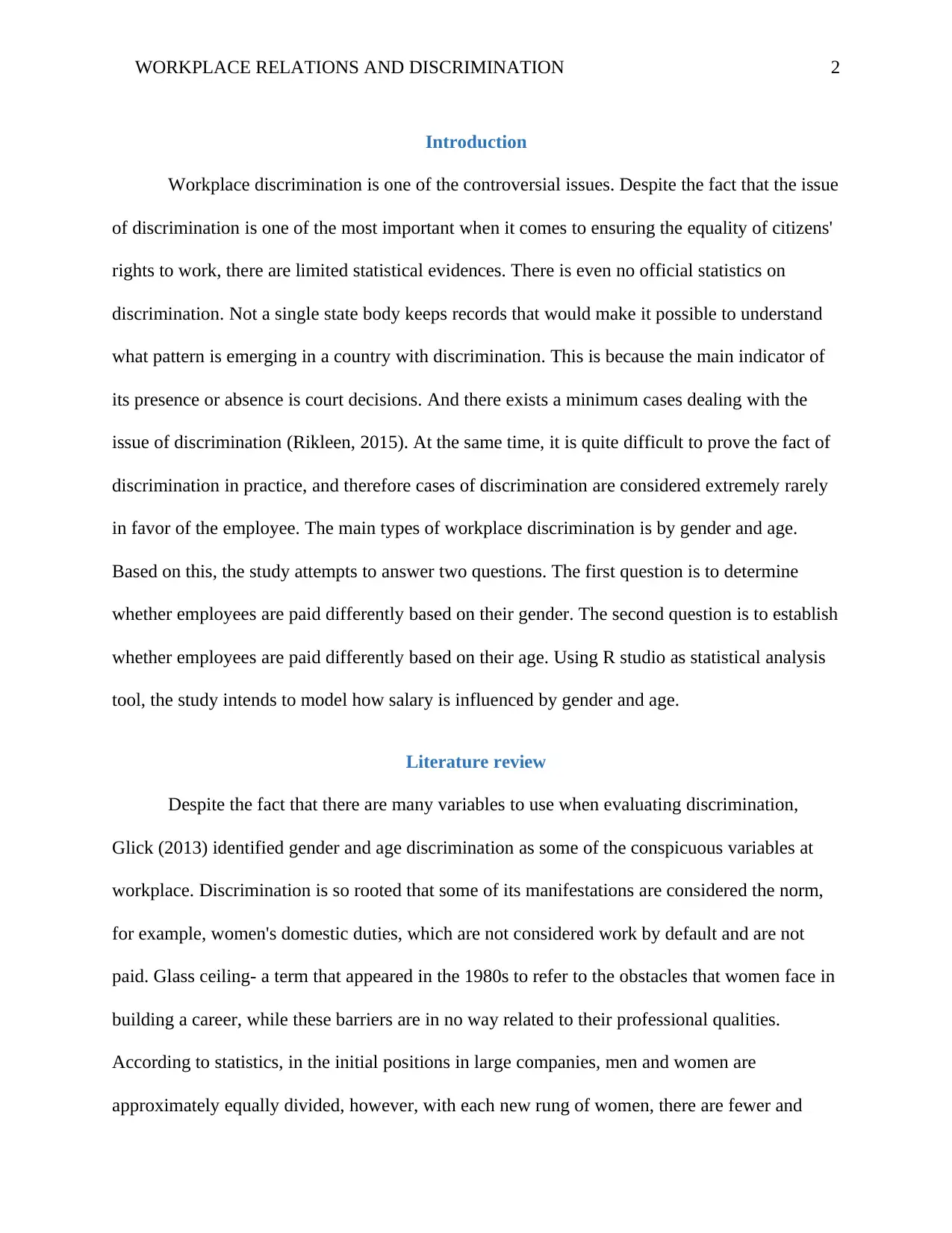
WORKPLACE RELATIONS AND DISCRIMINATION 2
Introduction
Workplace discrimination is one of the controversial issues. Despite the fact that the issue
of discrimination is one of the most important when it comes to ensuring the equality of citizens'
rights to work, there are limited statistical evidences. There is even no official statistics on
discrimination. Not a single state body keeps records that would make it possible to understand
what pattern is emerging in a country with discrimination. This is because the main indicator of
its presence or absence is court decisions. And there exists a minimum cases dealing with the
issue of discrimination (Rikleen, 2015). At the same time, it is quite difficult to prove the fact of
discrimination in practice, and therefore cases of discrimination are considered extremely rarely
in favor of the employee. The main types of workplace discrimination is by gender and age.
Based on this, the study attempts to answer two questions. The first question is to determine
whether employees are paid differently based on their gender. The second question is to establish
whether employees are paid differently based on their age. Using R studio as statistical analysis
tool, the study intends to model how salary is influenced by gender and age.
Literature review
Despite the fact that there are many variables to use when evaluating discrimination,
Glick (2013) identified gender and age discrimination as some of the conspicuous variables at
workplace. Discrimination is so rooted that some of its manifestations are considered the norm,
for example, women's domestic duties, which are not considered work by default and are not
paid. Glass ceiling- a term that appeared in the 1980s to refer to the obstacles that women face in
building a career, while these barriers are in no way related to their professional qualities.
According to statistics, in the initial positions in large companies, men and women are
approximately equally divided, however, with each new rung of women, there are fewer and
Introduction
Workplace discrimination is one of the controversial issues. Despite the fact that the issue
of discrimination is one of the most important when it comes to ensuring the equality of citizens'
rights to work, there are limited statistical evidences. There is even no official statistics on
discrimination. Not a single state body keeps records that would make it possible to understand
what pattern is emerging in a country with discrimination. This is because the main indicator of
its presence or absence is court decisions. And there exists a minimum cases dealing with the
issue of discrimination (Rikleen, 2015). At the same time, it is quite difficult to prove the fact of
discrimination in practice, and therefore cases of discrimination are considered extremely rarely
in favor of the employee. The main types of workplace discrimination is by gender and age.
Based on this, the study attempts to answer two questions. The first question is to determine
whether employees are paid differently based on their gender. The second question is to establish
whether employees are paid differently based on their age. Using R studio as statistical analysis
tool, the study intends to model how salary is influenced by gender and age.
Literature review
Despite the fact that there are many variables to use when evaluating discrimination,
Glick (2013) identified gender and age discrimination as some of the conspicuous variables at
workplace. Discrimination is so rooted that some of its manifestations are considered the norm,
for example, women's domestic duties, which are not considered work by default and are not
paid. Glass ceiling- a term that appeared in the 1980s to refer to the obstacles that women face in
building a career, while these barriers are in no way related to their professional qualities.
According to statistics, in the initial positions in large companies, men and women are
approximately equally divided, however, with each new rung of women, there are fewer and
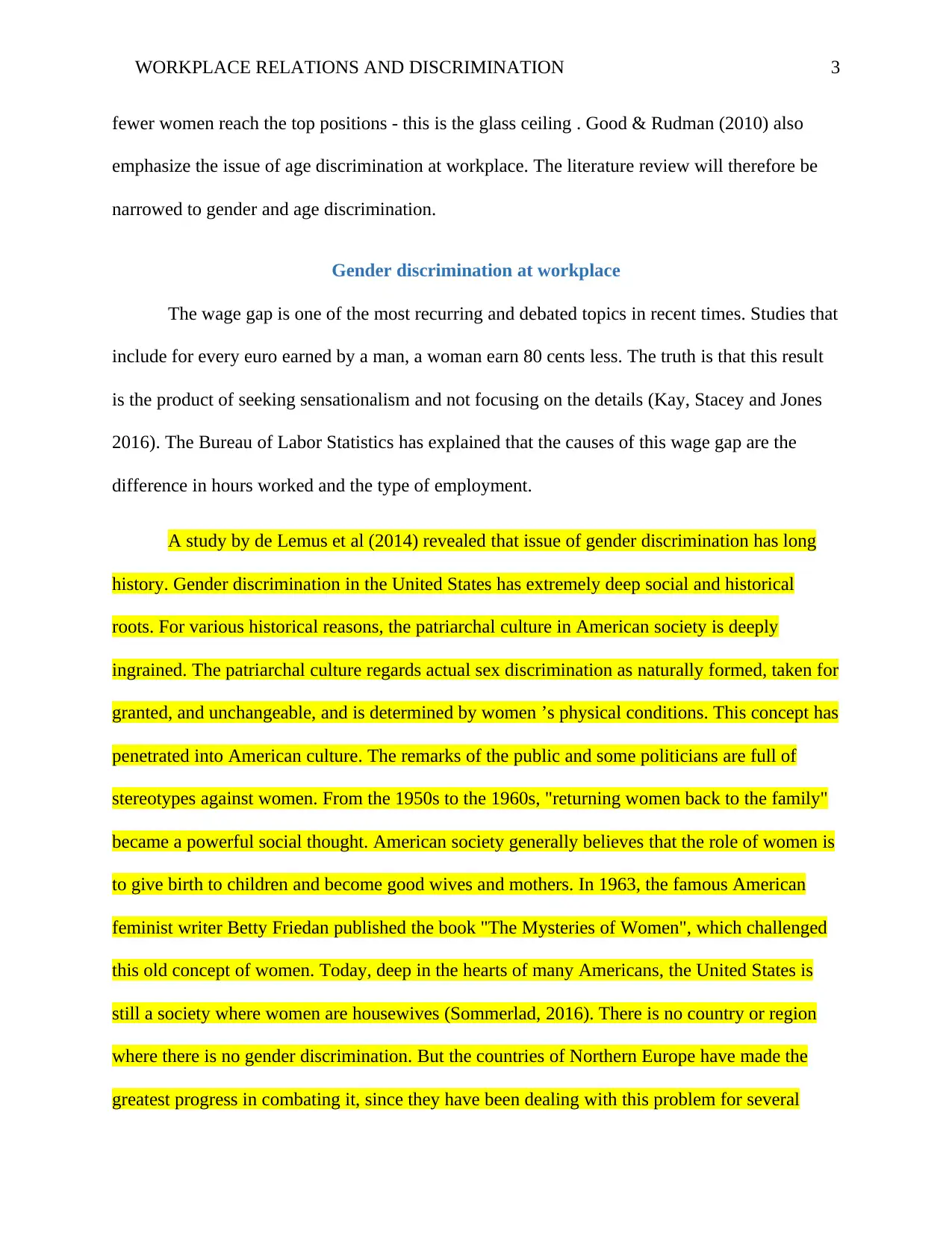
WORKPLACE RELATIONS AND DISCRIMINATION 3
fewer women reach the top positions - this is the glass ceiling . Good & Rudman (2010) also
emphasize the issue of age discrimination at workplace. The literature review will therefore be
narrowed to gender and age discrimination.
Gender discrimination at workplace
The wage gap is one of the most recurring and debated topics in recent times. Studies that
include for every euro earned by a man, a woman earn 80 cents less. The truth is that this result
is the product of seeking sensationalism and not focusing on the details (Kay, Stacey and Jones
2016). The Bureau of Labor Statistics has explained that the causes of this wage gap are the
difference in hours worked and the type of employment.
A study by de Lemus et al (2014) revealed that issue of gender discrimination has long
history. Gender discrimination in the United States has extremely deep social and historical
roots. For various historical reasons, the patriarchal culture in American society is deeply
ingrained. The patriarchal culture regards actual sex discrimination as naturally formed, taken for
granted, and unchangeable, and is determined by women ’s physical conditions. This concept has
penetrated into American culture. The remarks of the public and some politicians are full of
stereotypes against women. From the 1950s to the 1960s, "returning women back to the family"
became a powerful social thought. American society generally believes that the role of women is
to give birth to children and become good wives and mothers. In 1963, the famous American
feminist writer Betty Friedan published the book "The Mysteries of Women", which challenged
this old concept of women. Today, deep in the hearts of many Americans, the United States is
still a society where women are housewives (Sommerlad, 2016). There is no country or region
where there is no gender discrimination. But the countries of Northern Europe have made the
greatest progress in combating it, since they have been dealing with this problem for several
fewer women reach the top positions - this is the glass ceiling . Good & Rudman (2010) also
emphasize the issue of age discrimination at workplace. The literature review will therefore be
narrowed to gender and age discrimination.
Gender discrimination at workplace
The wage gap is one of the most recurring and debated topics in recent times. Studies that
include for every euro earned by a man, a woman earn 80 cents less. The truth is that this result
is the product of seeking sensationalism and not focusing on the details (Kay, Stacey and Jones
2016). The Bureau of Labor Statistics has explained that the causes of this wage gap are the
difference in hours worked and the type of employment.
A study by de Lemus et al (2014) revealed that issue of gender discrimination has long
history. Gender discrimination in the United States has extremely deep social and historical
roots. For various historical reasons, the patriarchal culture in American society is deeply
ingrained. The patriarchal culture regards actual sex discrimination as naturally formed, taken for
granted, and unchangeable, and is determined by women ’s physical conditions. This concept has
penetrated into American culture. The remarks of the public and some politicians are full of
stereotypes against women. From the 1950s to the 1960s, "returning women back to the family"
became a powerful social thought. American society generally believes that the role of women is
to give birth to children and become good wives and mothers. In 1963, the famous American
feminist writer Betty Friedan published the book "The Mysteries of Women", which challenged
this old concept of women. Today, deep in the hearts of many Americans, the United States is
still a society where women are housewives (Sommerlad, 2016). There is no country or region
where there is no gender discrimination. But the countries of Northern Europe have made the
greatest progress in combating it, since they have been dealing with this problem for several
⊘ This is a preview!⊘
Do you want full access?
Subscribe today to unlock all pages.

Trusted by 1+ million students worldwide
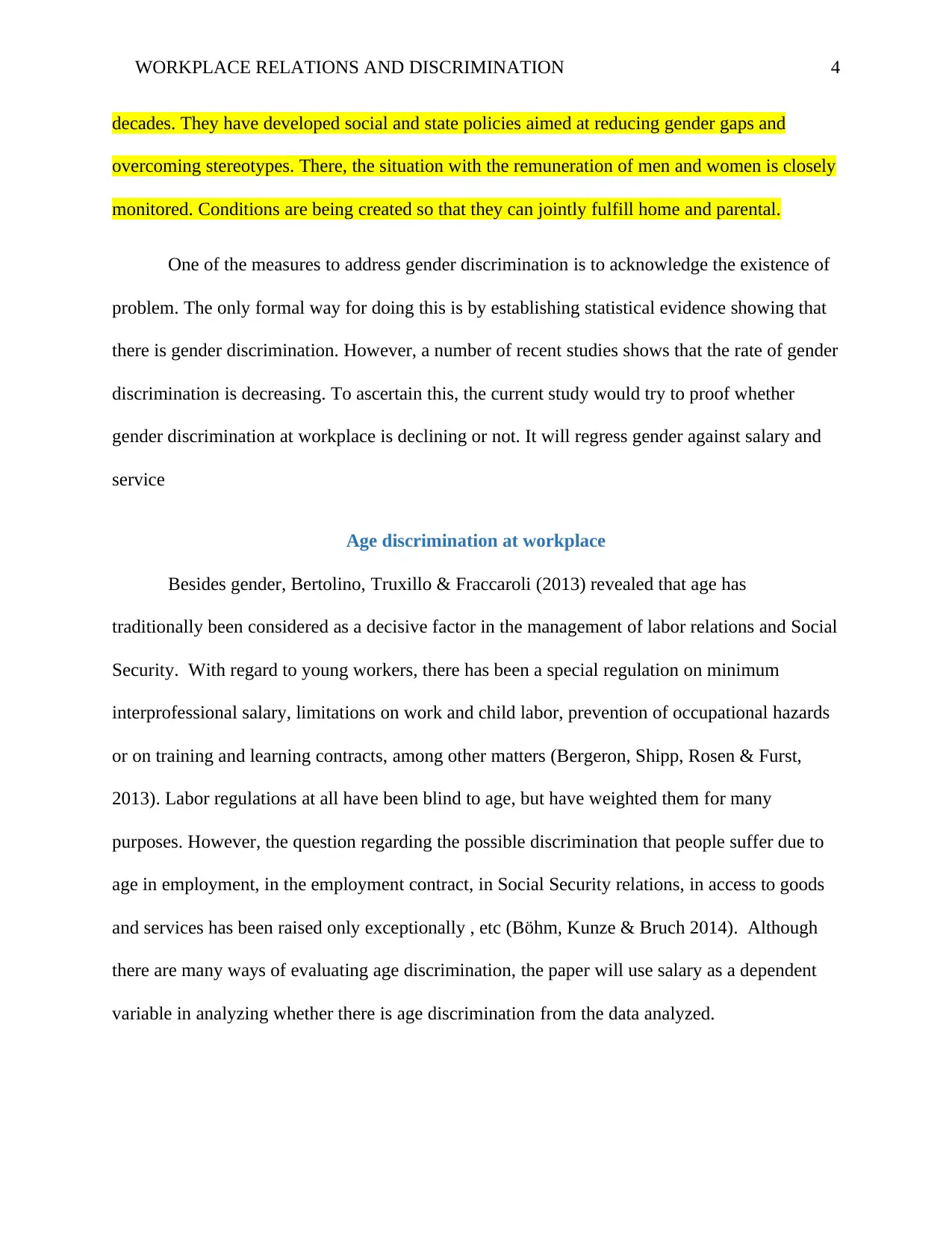
WORKPLACE RELATIONS AND DISCRIMINATION 4
decades. They have developed social and state policies aimed at reducing gender gaps and
overcoming stereotypes. There, the situation with the remuneration of men and women is closely
monitored. Conditions are being created so that they can jointly fulfill home and parental.
One of the measures to address gender discrimination is to acknowledge the existence of
problem. The only formal way for doing this is by establishing statistical evidence showing that
there is gender discrimination. However, a number of recent studies shows that the rate of gender
discrimination is decreasing. To ascertain this, the current study would try to proof whether
gender discrimination at workplace is declining or not. It will regress gender against salary and
service
Age discrimination at workplace
Besides gender, Bertolino, Truxillo & Fraccaroli (2013) revealed that age has
traditionally been considered as a decisive factor in the management of labor relations and Social
Security. With regard to young workers, there has been a special regulation on minimum
interprofessional salary, limitations on work and child labor, prevention of occupational hazards
or on training and learning contracts, among other matters (Bergeron, Shipp, Rosen & Furst,
2013). Labor regulations at all have been blind to age, but have weighted them for many
purposes. However, the question regarding the possible discrimination that people suffer due to
age in employment, in the employment contract, in Social Security relations, in access to goods
and services has been raised only exceptionally , etc (Böhm, Kunze & Bruch 2014). Although
there are many ways of evaluating age discrimination, the paper will use salary as a dependent
variable in analyzing whether there is age discrimination from the data analyzed.
decades. They have developed social and state policies aimed at reducing gender gaps and
overcoming stereotypes. There, the situation with the remuneration of men and women is closely
monitored. Conditions are being created so that they can jointly fulfill home and parental.
One of the measures to address gender discrimination is to acknowledge the existence of
problem. The only formal way for doing this is by establishing statistical evidence showing that
there is gender discrimination. However, a number of recent studies shows that the rate of gender
discrimination is decreasing. To ascertain this, the current study would try to proof whether
gender discrimination at workplace is declining or not. It will regress gender against salary and
service
Age discrimination at workplace
Besides gender, Bertolino, Truxillo & Fraccaroli (2013) revealed that age has
traditionally been considered as a decisive factor in the management of labor relations and Social
Security. With regard to young workers, there has been a special regulation on minimum
interprofessional salary, limitations on work and child labor, prevention of occupational hazards
or on training and learning contracts, among other matters (Bergeron, Shipp, Rosen & Furst,
2013). Labor regulations at all have been blind to age, but have weighted them for many
purposes. However, the question regarding the possible discrimination that people suffer due to
age in employment, in the employment contract, in Social Security relations, in access to goods
and services has been raised only exceptionally , etc (Böhm, Kunze & Bruch 2014). Although
there are many ways of evaluating age discrimination, the paper will use salary as a dependent
variable in analyzing whether there is age discrimination from the data analyzed.
Paraphrase This Document
Need a fresh take? Get an instant paraphrase of this document with our AI Paraphraser
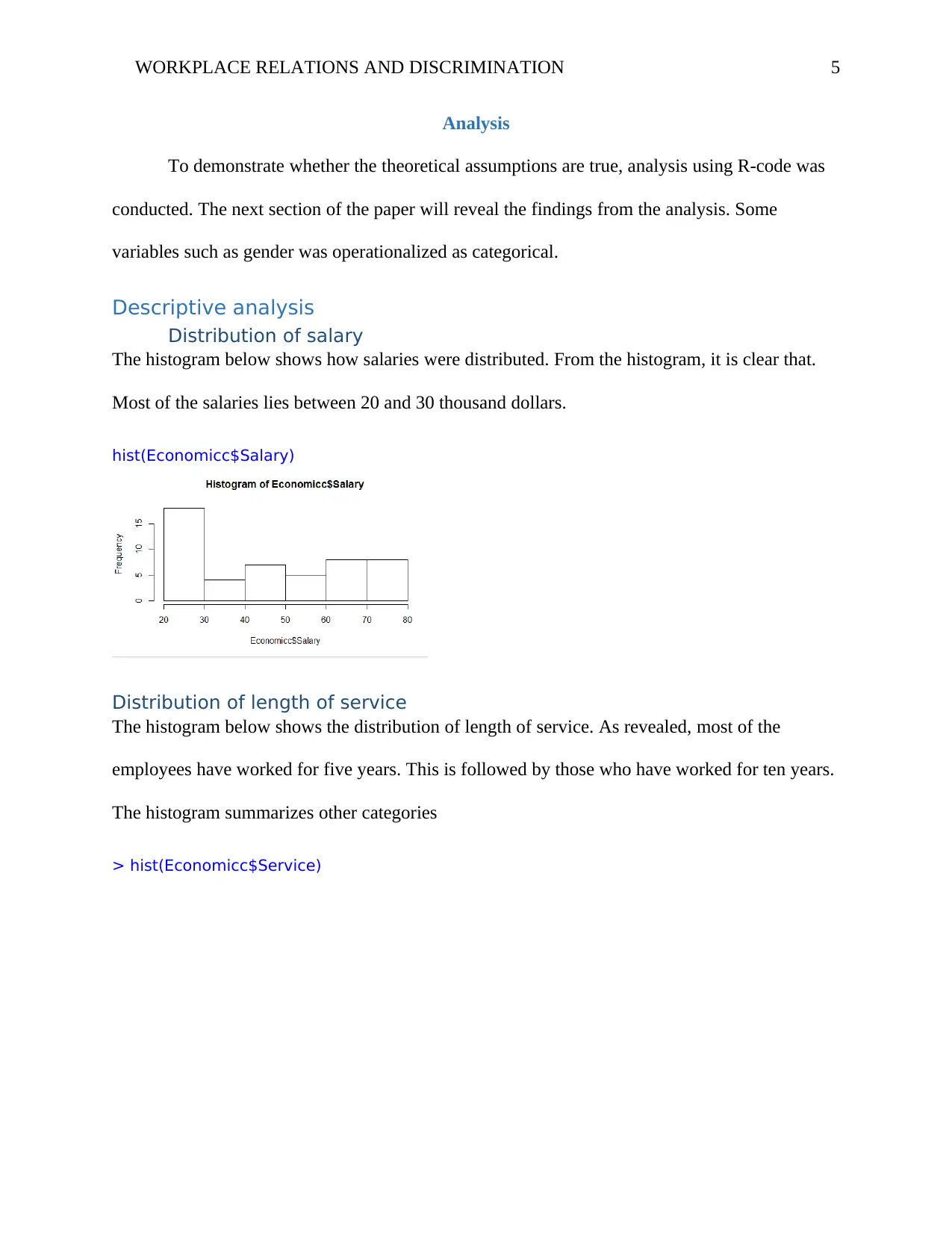
WORKPLACE RELATIONS AND DISCRIMINATION 5
Analysis
To demonstrate whether the theoretical assumptions are true, analysis using R-code was
conducted. The next section of the paper will reveal the findings from the analysis. Some
variables such as gender was operationalized as categorical.
Descriptive analysis
Distribution of salary
The histogram below shows how salaries were distributed. From the histogram, it is clear that.
Most of the salaries lies between 20 and 30 thousand dollars.
hist(Economicc$Salary)
Distribution of length of service
The histogram below shows the distribution of length of service. As revealed, most of the
employees have worked for five years. This is followed by those who have worked for ten years.
The histogram summarizes other categories
> hist(Economicc$Service)
Analysis
To demonstrate whether the theoretical assumptions are true, analysis using R-code was
conducted. The next section of the paper will reveal the findings from the analysis. Some
variables such as gender was operationalized as categorical.
Descriptive analysis
Distribution of salary
The histogram below shows how salaries were distributed. From the histogram, it is clear that.
Most of the salaries lies between 20 and 30 thousand dollars.
hist(Economicc$Salary)
Distribution of length of service
The histogram below shows the distribution of length of service. As revealed, most of the
employees have worked for five years. This is followed by those who have worked for ten years.
The histogram summarizes other categories
> hist(Economicc$Service)
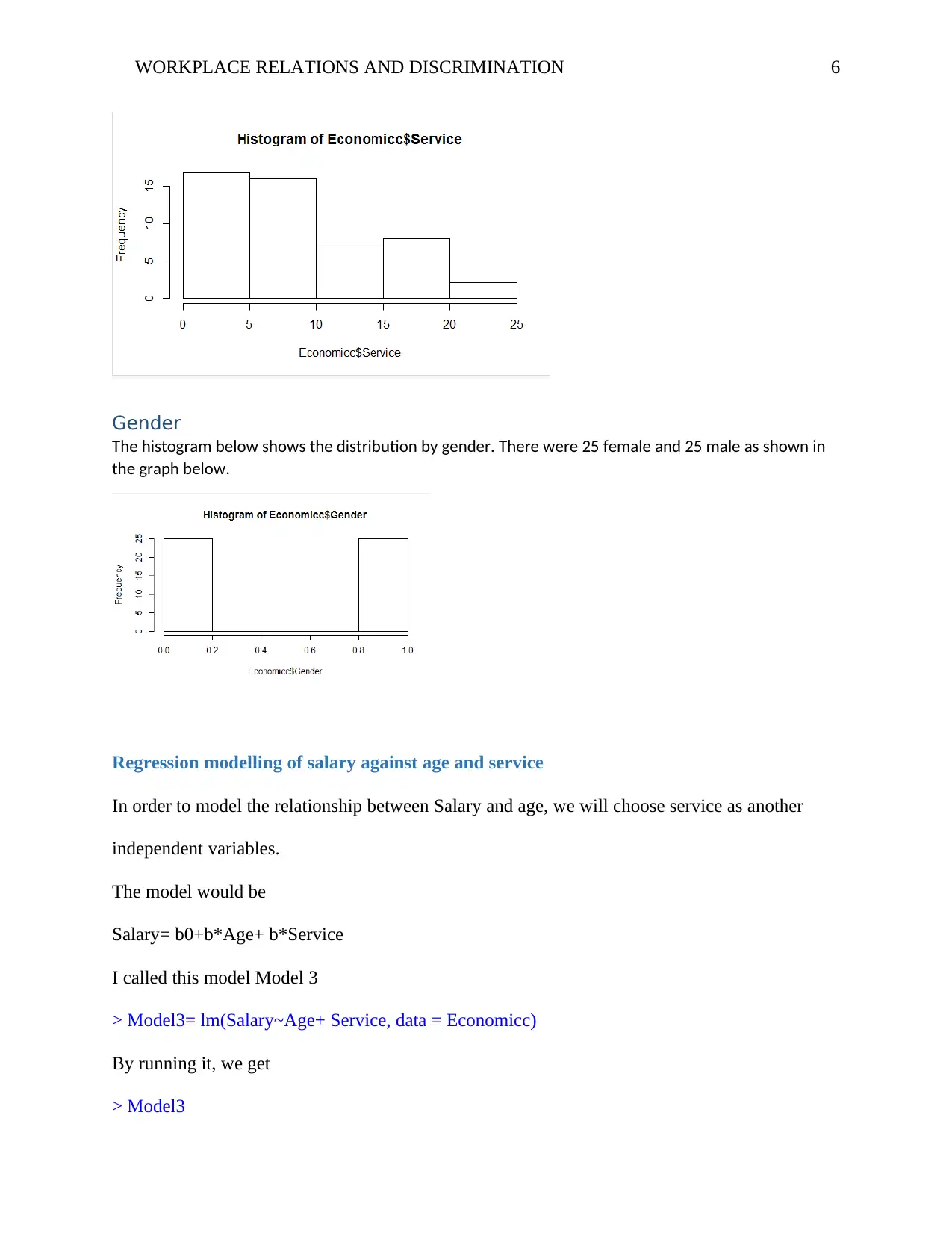
WORKPLACE RELATIONS AND DISCRIMINATION 6
Gender
The histogram below shows the distribution by gender. There were 25 female and 25 male as shown in
the graph below.
Regression modelling of salary against age and service
In order to model the relationship between Salary and age, we will choose service as another
independent variables.
The model would be
Salary= b0+b*Age+ b*Service
I called this model Model 3
> Model3= lm(Salary~Age+ Service, data = Economicc)
By running it, we get
> Model3
Gender
The histogram below shows the distribution by gender. There were 25 female and 25 male as shown in
the graph below.
Regression modelling of salary against age and service
In order to model the relationship between Salary and age, we will choose service as another
independent variables.
The model would be
Salary= b0+b*Age+ b*Service
I called this model Model 3
> Model3= lm(Salary~Age+ Service, data = Economicc)
By running it, we get
> Model3
⊘ This is a preview!⊘
Do you want full access?
Subscribe today to unlock all pages.

Trusted by 1+ million students worldwide
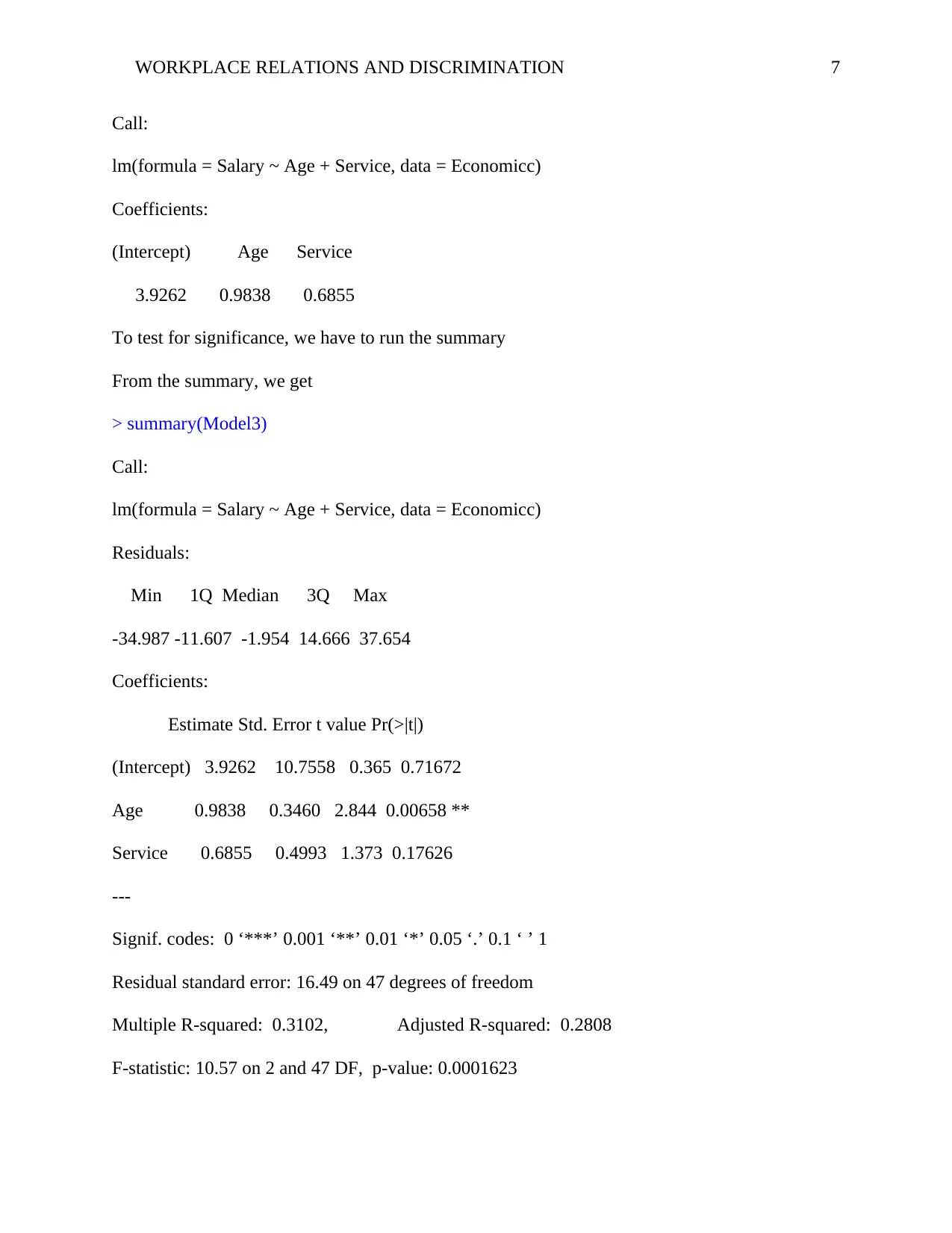
WORKPLACE RELATIONS AND DISCRIMINATION 7
Call:
lm(formula = Salary ~ Age + Service, data = Economicc)
Coefficients:
(Intercept) Age Service
3.9262 0.9838 0.6855
To test for significance, we have to run the summary
From the summary, we get
> summary(Model3)
Call:
lm(formula = Salary ~ Age + Service, data = Economicc)
Residuals:
Min 1Q Median 3Q Max
-34.987 -11.607 -1.954 14.666 37.654
Coefficients:
Estimate Std. Error t value Pr(>|t|)
(Intercept) 3.9262 10.7558 0.365 0.71672
Age 0.9838 0.3460 2.844 0.00658 **
Service 0.6855 0.4993 1.373 0.17626
---
Signif. codes: 0 ‘***’ 0.001 ‘**’ 0.01 ‘*’ 0.05 ‘.’ 0.1 ‘ ’ 1
Residual standard error: 16.49 on 47 degrees of freedom
Multiple R-squared: 0.3102, Adjusted R-squared: 0.2808
F-statistic: 10.57 on 2 and 47 DF, p-value: 0.0001623
Call:
lm(formula = Salary ~ Age + Service, data = Economicc)
Coefficients:
(Intercept) Age Service
3.9262 0.9838 0.6855
To test for significance, we have to run the summary
From the summary, we get
> summary(Model3)
Call:
lm(formula = Salary ~ Age + Service, data = Economicc)
Residuals:
Min 1Q Median 3Q Max
-34.987 -11.607 -1.954 14.666 37.654
Coefficients:
Estimate Std. Error t value Pr(>|t|)
(Intercept) 3.9262 10.7558 0.365 0.71672
Age 0.9838 0.3460 2.844 0.00658 **
Service 0.6855 0.4993 1.373 0.17626
---
Signif. codes: 0 ‘***’ 0.001 ‘**’ 0.01 ‘*’ 0.05 ‘.’ 0.1 ‘ ’ 1
Residual standard error: 16.49 on 47 degrees of freedom
Multiple R-squared: 0.3102, Adjusted R-squared: 0.2808
F-statistic: 10.57 on 2 and 47 DF, p-value: 0.0001623
Paraphrase This Document
Need a fresh take? Get an instant paraphrase of this document with our AI Paraphraser
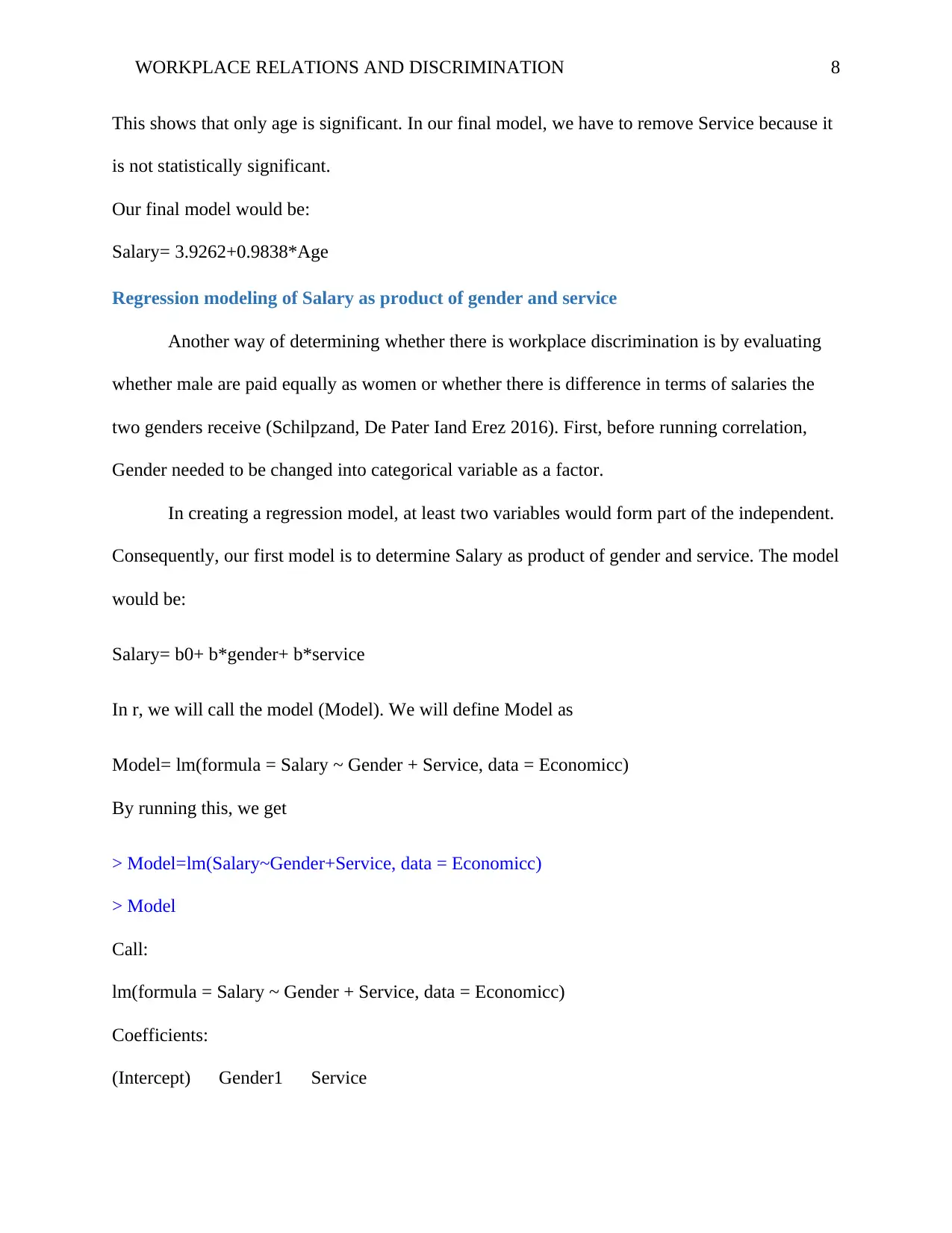
WORKPLACE RELATIONS AND DISCRIMINATION 8
This shows that only age is significant. In our final model, we have to remove Service because it
is not statistically significant.
Our final model would be:
Salary= 3.9262+0.9838*Age
Regression modeling of Salary as product of gender and service
Another way of determining whether there is workplace discrimination is by evaluating
whether male are paid equally as women or whether there is difference in terms of salaries the
two genders receive (Schilpzand, De Pater Iand Erez 2016). First, before running correlation,
Gender needed to be changed into categorical variable as a factor.
In creating a regression model, at least two variables would form part of the independent.
Consequently, our first model is to determine Salary as product of gender and service. The model
would be:
Salary= b0+ b*gender+ b*service
In r, we will call the model (Model). We will define Model as
Model= lm(formula = Salary ~ Gender + Service, data = Economicc)
By running this, we get
> Model=lm(Salary~Gender+Service, data = Economicc)
> Model
Call:
lm(formula = Salary ~ Gender + Service, data = Economicc)
Coefficients:
(Intercept) Gender1 Service
This shows that only age is significant. In our final model, we have to remove Service because it
is not statistically significant.
Our final model would be:
Salary= 3.9262+0.9838*Age
Regression modeling of Salary as product of gender and service
Another way of determining whether there is workplace discrimination is by evaluating
whether male are paid equally as women or whether there is difference in terms of salaries the
two genders receive (Schilpzand, De Pater Iand Erez 2016). First, before running correlation,
Gender needed to be changed into categorical variable as a factor.
In creating a regression model, at least two variables would form part of the independent.
Consequently, our first model is to determine Salary as product of gender and service. The model
would be:
Salary= b0+ b*gender+ b*service
In r, we will call the model (Model). We will define Model as
Model= lm(formula = Salary ~ Gender + Service, data = Economicc)
By running this, we get
> Model=lm(Salary~Gender+Service, data = Economicc)
> Model
Call:
lm(formula = Salary ~ Gender + Service, data = Economicc)
Coefficients:
(Intercept) Gender1 Service
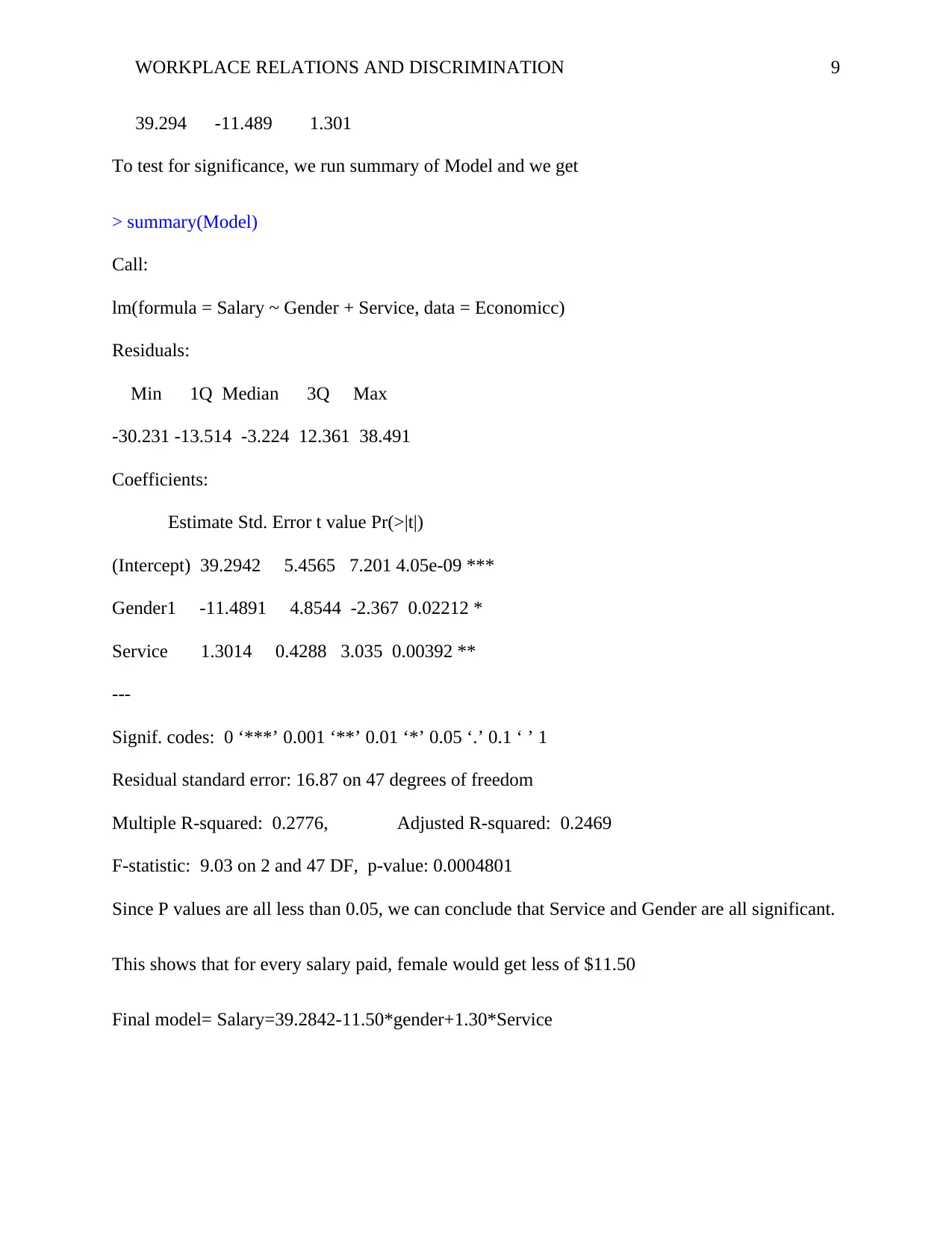
WORKPLACE RELATIONS AND DISCRIMINATION 9
39.294 -11.489 1.301
To test for significance, we run summary of Model and we get
> summary(Model)
Call:
lm(formula = Salary ~ Gender + Service, data = Economicc)
Residuals:
Min 1Q Median 3Q Max
-30.231 -13.514 -3.224 12.361 38.491
Coefficients:
Estimate Std. Error t value Pr(>|t|)
(Intercept) 39.2942 5.4565 7.201 4.05e-09 ***
Gender1 -11.4891 4.8544 -2.367 0.02212 *
Service 1.3014 0.4288 3.035 0.00392 **
---
Signif. codes: 0 ‘***’ 0.001 ‘**’ 0.01 ‘*’ 0.05 ‘.’ 0.1 ‘ ’ 1
Residual standard error: 16.87 on 47 degrees of freedom
Multiple R-squared: 0.2776, Adjusted R-squared: 0.2469
F-statistic: 9.03 on 2 and 47 DF, p-value: 0.0004801
Since P values are all less than 0.05, we can conclude that Service and Gender are all significant.
This shows that for every salary paid, female would get less of $11.50
Final model= Salary=39.2842-11.50*gender+1.30*Service
39.294 -11.489 1.301
To test for significance, we run summary of Model and we get
> summary(Model)
Call:
lm(formula = Salary ~ Gender + Service, data = Economicc)
Residuals:
Min 1Q Median 3Q Max
-30.231 -13.514 -3.224 12.361 38.491
Coefficients:
Estimate Std. Error t value Pr(>|t|)
(Intercept) 39.2942 5.4565 7.201 4.05e-09 ***
Gender1 -11.4891 4.8544 -2.367 0.02212 *
Service 1.3014 0.4288 3.035 0.00392 **
---
Signif. codes: 0 ‘***’ 0.001 ‘**’ 0.01 ‘*’ 0.05 ‘.’ 0.1 ‘ ’ 1
Residual standard error: 16.87 on 47 degrees of freedom
Multiple R-squared: 0.2776, Adjusted R-squared: 0.2469
F-statistic: 9.03 on 2 and 47 DF, p-value: 0.0004801
Since P values are all less than 0.05, we can conclude that Service and Gender are all significant.
This shows that for every salary paid, female would get less of $11.50
Final model= Salary=39.2842-11.50*gender+1.30*Service
⊘ This is a preview!⊘
Do you want full access?
Subscribe today to unlock all pages.

Trusted by 1+ million students worldwide
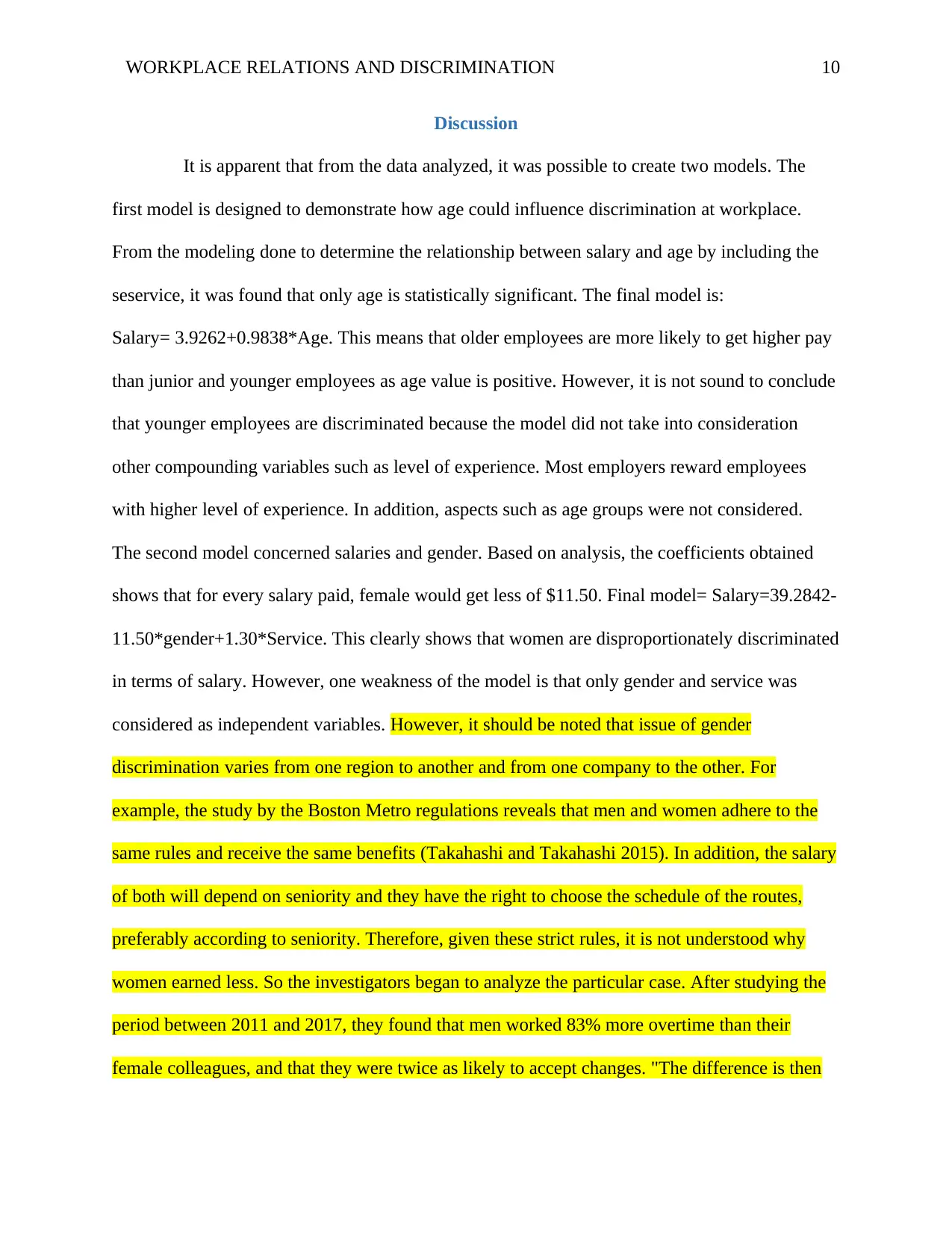
WORKPLACE RELATIONS AND DISCRIMINATION 10
Discussion
It is apparent that from the data analyzed, it was possible to create two models. The
first model is designed to demonstrate how age could influence discrimination at workplace.
From the modeling done to determine the relationship between salary and age by including the
seservice, it was found that only age is statistically significant. The final model is:
Salary= 3.9262+0.9838*Age. This means that older employees are more likely to get higher pay
than junior and younger employees as age value is positive. However, it is not sound to conclude
that younger employees are discriminated because the model did not take into consideration
other compounding variables such as level of experience. Most employers reward employees
with higher level of experience. In addition, aspects such as age groups were not considered.
The second model concerned salaries and gender. Based on analysis, the coefficients obtained
shows that for every salary paid, female would get less of $11.50. Final model= Salary=39.2842-
11.50*gender+1.30*Service. This clearly shows that women are disproportionately discriminated
in terms of salary. However, one weakness of the model is that only gender and service was
considered as independent variables. However, it should be noted that issue of gender
discrimination varies from one region to another and from one company to the other. For
example, the study by the Boston Metro regulations reveals that men and women adhere to the
same rules and receive the same benefits (Takahashi and Takahashi 2015). In addition, the salary
of both will depend on seniority and they have the right to choose the schedule of the routes,
preferably according to seniority. Therefore, given these strict rules, it is not understood why
women earned less. So the investigators began to analyze the particular case. After studying the
period between 2011 and 2017, they found that men worked 83% more overtime than their
female colleagues, and that they were twice as likely to accept changes. "The difference is then
Discussion
It is apparent that from the data analyzed, it was possible to create two models. The
first model is designed to demonstrate how age could influence discrimination at workplace.
From the modeling done to determine the relationship between salary and age by including the
seservice, it was found that only age is statistically significant. The final model is:
Salary= 3.9262+0.9838*Age. This means that older employees are more likely to get higher pay
than junior and younger employees as age value is positive. However, it is not sound to conclude
that younger employees are discriminated because the model did not take into consideration
other compounding variables such as level of experience. Most employers reward employees
with higher level of experience. In addition, aspects such as age groups were not considered.
The second model concerned salaries and gender. Based on analysis, the coefficients obtained
shows that for every salary paid, female would get less of $11.50. Final model= Salary=39.2842-
11.50*gender+1.30*Service. This clearly shows that women are disproportionately discriminated
in terms of salary. However, one weakness of the model is that only gender and service was
considered as independent variables. However, it should be noted that issue of gender
discrimination varies from one region to another and from one company to the other. For
example, the study by the Boston Metro regulations reveals that men and women adhere to the
same rules and receive the same benefits (Takahashi and Takahashi 2015). In addition, the salary
of both will depend on seniority and they have the right to choose the schedule of the routes,
preferably according to seniority. Therefore, given these strict rules, it is not understood why
women earned less. So the investigators began to analyze the particular case. After studying the
period between 2011 and 2017, they found that men worked 83% more overtime than their
female colleagues, and that they were twice as likely to accept changes. "The difference is then
Paraphrase This Document
Need a fresh take? Get an instant paraphrase of this document with our AI Paraphraser
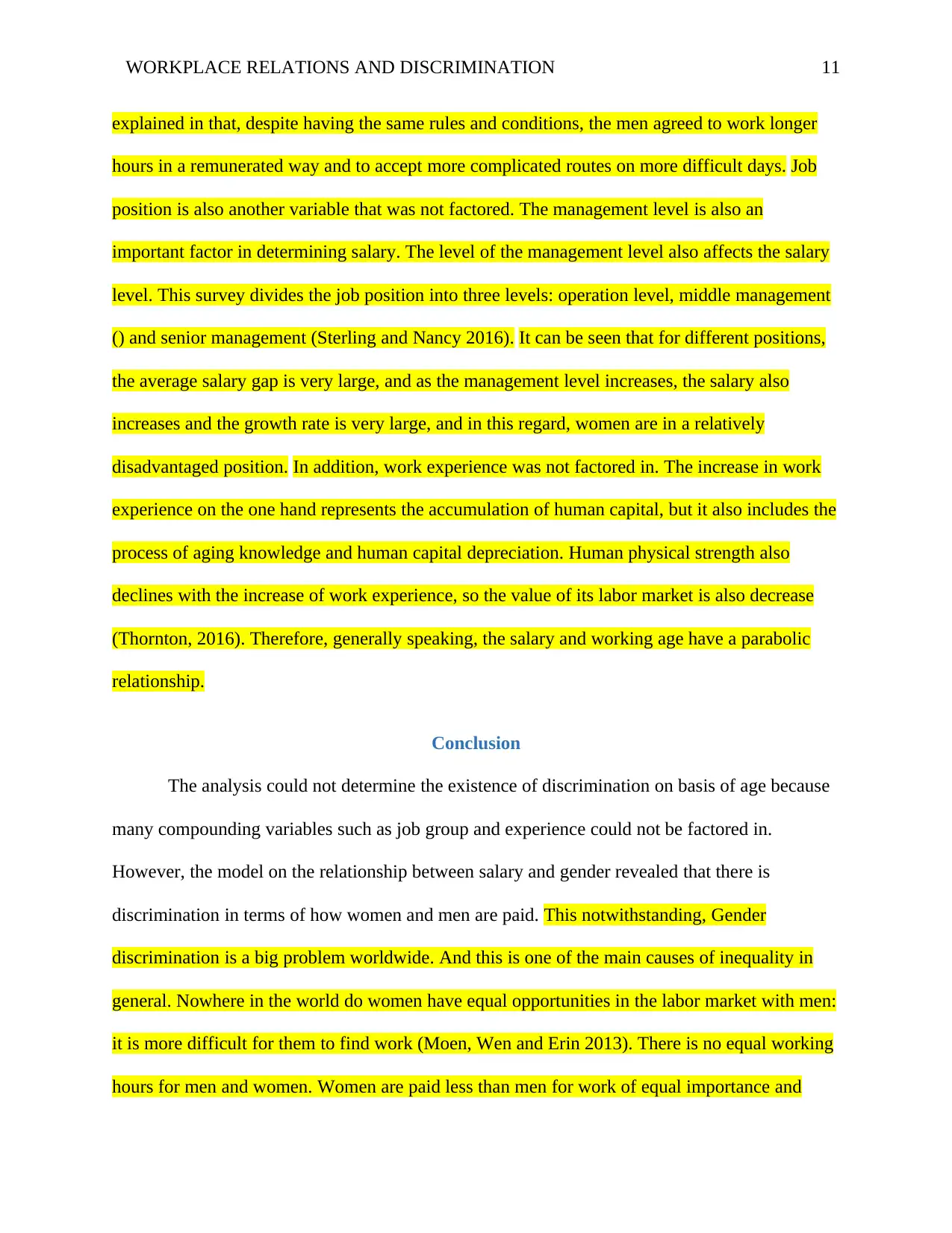
WORKPLACE RELATIONS AND DISCRIMINATION 11
explained in that, despite having the same rules and conditions, the men agreed to work longer
hours in a remunerated way and to accept more complicated routes on more difficult days. Job
position is also another variable that was not factored. The management level is also an
important factor in determining salary. The level of the management level also affects the salary
level. This survey divides the job position into three levels: operation level, middle management
() and senior management (Sterling and Nancy 2016). It can be seen that for different positions,
the average salary gap is very large, and as the management level increases, the salary also
increases and the growth rate is very large, and in this regard, women are in a relatively
disadvantaged position. In addition, work experience was not factored in. The increase in work
experience on the one hand represents the accumulation of human capital, but it also includes the
process of aging knowledge and human capital depreciation. Human physical strength also
declines with the increase of work experience, so the value of its labor market is also decrease
(Thornton, 2016). Therefore, generally speaking, the salary and working age have a parabolic
relationship.
Conclusion
The analysis could not determine the existence of discrimination on basis of age because
many compounding variables such as job group and experience could not be factored in.
However, the model on the relationship between salary and gender revealed that there is
discrimination in terms of how women and men are paid. This notwithstanding, Gender
discrimination is a big problem worldwide. And this is one of the main causes of inequality in
general. Nowhere in the world do women have equal opportunities in the labor market with men:
it is more difficult for them to find work (Moen, Wen and Erin 2013). There is no equal working
hours for men and women. Women are paid less than men for work of equal importance and
explained in that, despite having the same rules and conditions, the men agreed to work longer
hours in a remunerated way and to accept more complicated routes on more difficult days. Job
position is also another variable that was not factored. The management level is also an
important factor in determining salary. The level of the management level also affects the salary
level. This survey divides the job position into three levels: operation level, middle management
() and senior management (Sterling and Nancy 2016). It can be seen that for different positions,
the average salary gap is very large, and as the management level increases, the salary also
increases and the growth rate is very large, and in this regard, women are in a relatively
disadvantaged position. In addition, work experience was not factored in. The increase in work
experience on the one hand represents the accumulation of human capital, but it also includes the
process of aging knowledge and human capital depreciation. Human physical strength also
declines with the increase of work experience, so the value of its labor market is also decrease
(Thornton, 2016). Therefore, generally speaking, the salary and working age have a parabolic
relationship.
Conclusion
The analysis could not determine the existence of discrimination on basis of age because
many compounding variables such as job group and experience could not be factored in.
However, the model on the relationship between salary and gender revealed that there is
discrimination in terms of how women and men are paid. This notwithstanding, Gender
discrimination is a big problem worldwide. And this is one of the main causes of inequality in
general. Nowhere in the world do women have equal opportunities in the labor market with men:
it is more difficult for them to find work (Moen, Wen and Erin 2013). There is no equal working
hours for men and women. Women are paid less than men for work of equal importance and
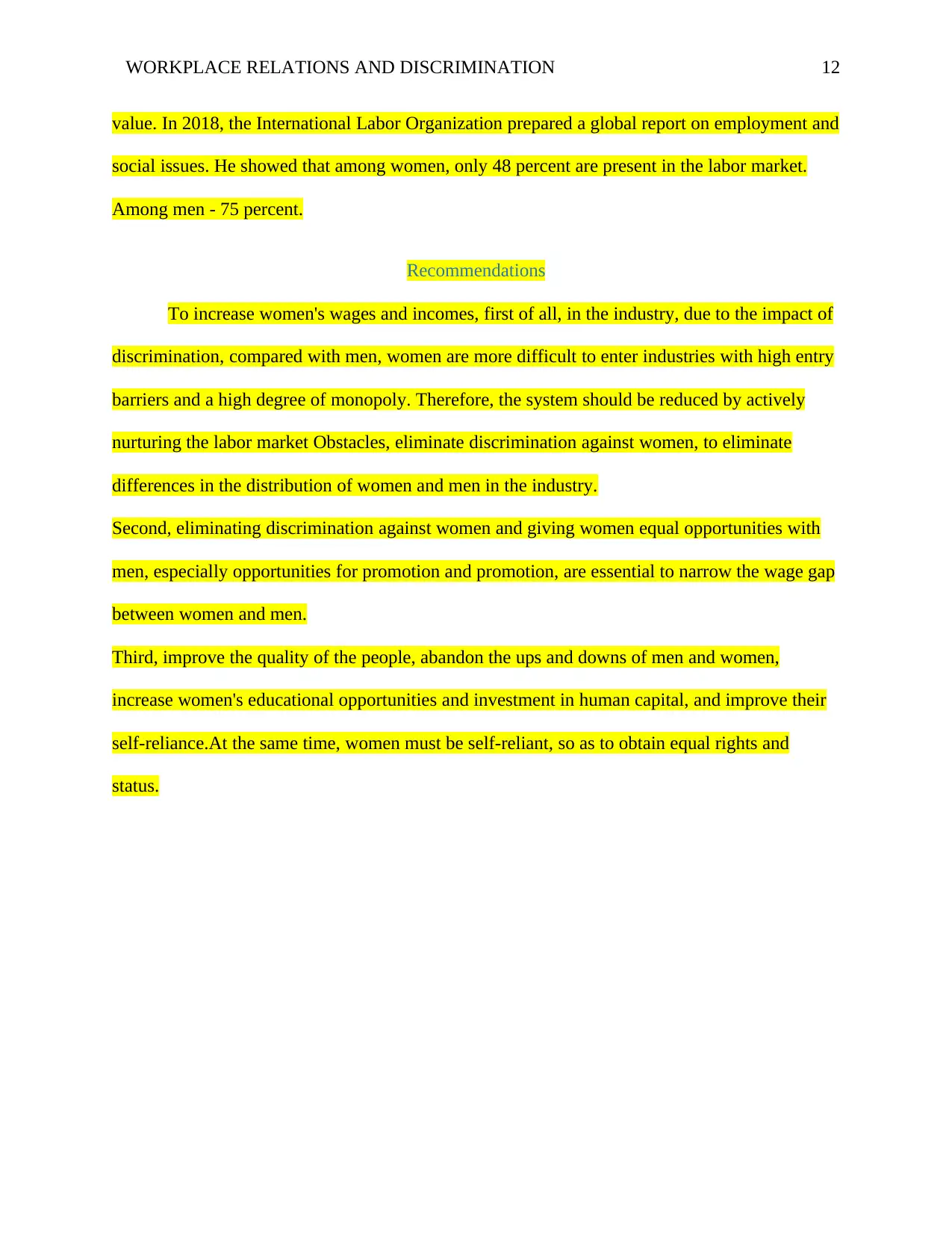
WORKPLACE RELATIONS AND DISCRIMINATION 12
value. In 2018, the International Labor Organization prepared a global report on employment and
social issues. He showed that among women, only 48 percent are present in the labor market.
Among men - 75 percent.
Recommendations
To increase women's wages and incomes, first of all, in the industry, due to the impact of
discrimination, compared with men, women are more difficult to enter industries with high entry
barriers and a high degree of monopoly. Therefore, the system should be reduced by actively
nurturing the labor market Obstacles, eliminate discrimination against women, to eliminate
differences in the distribution of women and men in the industry.
Second, eliminating discrimination against women and giving women equal opportunities with
men, especially opportunities for promotion and promotion, are essential to narrow the wage gap
between women and men.
Third, improve the quality of the people, abandon the ups and downs of men and women,
increase women's educational opportunities and investment in human capital, and improve their
self-reliance.At the same time, women must be self-reliant, so as to obtain equal rights and
status.
value. In 2018, the International Labor Organization prepared a global report on employment and
social issues. He showed that among women, only 48 percent are present in the labor market.
Among men - 75 percent.
Recommendations
To increase women's wages and incomes, first of all, in the industry, due to the impact of
discrimination, compared with men, women are more difficult to enter industries with high entry
barriers and a high degree of monopoly. Therefore, the system should be reduced by actively
nurturing the labor market Obstacles, eliminate discrimination against women, to eliminate
differences in the distribution of women and men in the industry.
Second, eliminating discrimination against women and giving women equal opportunities with
men, especially opportunities for promotion and promotion, are essential to narrow the wage gap
between women and men.
Third, improve the quality of the people, abandon the ups and downs of men and women,
increase women's educational opportunities and investment in human capital, and improve their
self-reliance.At the same time, women must be self-reliant, so as to obtain equal rights and
status.
⊘ This is a preview!⊘
Do you want full access?
Subscribe today to unlock all pages.

Trusted by 1+ million students worldwide
1 out of 14
Related Documents
Your All-in-One AI-Powered Toolkit for Academic Success.
+13062052269
info@desklib.com
Available 24*7 on WhatsApp / Email
![[object Object]](/_next/static/media/star-bottom.7253800d.svg)
Unlock your academic potential
Copyright © 2020–2025 A2Z Services. All Rights Reserved. Developed and managed by ZUCOL.




